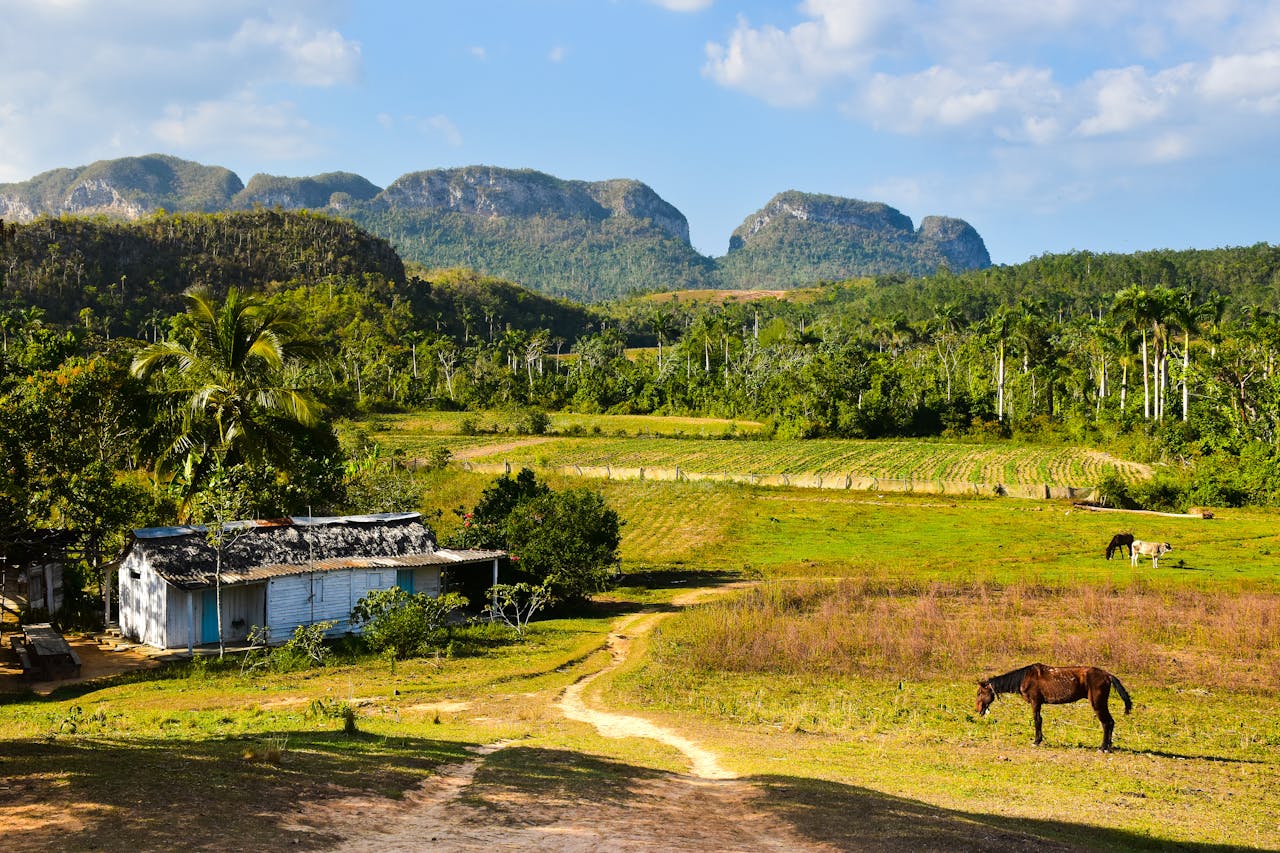Key milestones to a world living in harmony with nature
FAO action on five Biodiversity Plan targets

Biodiversity and agriculture are inseparable. The Kunming-Montreal Global Biodiversity Framework, or ‘The Biodiversity Plan’, adopted by countries in 2022, fully recognizes this close interdependence. The Biodiversity Plan sets out a pathway to a world living in harmony with nature by 2050, with more than half of its 23 targets relating to agrifood systems. FAO is playing an active role in supporting countries to implement these ambitious targets and its four Goals. In reality, FAO’s projects and initiatives relate to most of the Biodiversity Plan targets, with the following five topping the list:
- Restore 30% of all Degraded Ecosystems (TARGET 2)

More than half of the high-impact projects in FAO’s USD 1.2 billion Green Climate Fund portfolio have a restoration component. One project, entitled “Increased climate resilience of rural households and communities through the rehabilitation of production landscapes in selected localities of the Republic of Cuba (IRES)”, graphically demonstrates the transformative effect of restoration efforts.
As a Small Island Developing State, Cuba is particularly vulnerable to the effects of climate change.
The provinces of Villa Clara, Matanzas and las Tunas have experienced recurring droughts, soil degradation and salinity. Vast tracts of land have been overrun by an invasive species called marabou or “the sickle bush”. A woody tree covered by thorns, it forms impenetrable thickets, forcing out livestock, agriculture, and people.
The FAO USD 120 million IRES project has provided smallholder farmers with large machinery and training. They have so far eradicated more than 5100 hectares (ha) of marabou and planted over 6500 ha of cleared land with fruit and forest trees and other crops, while carrying on livestock production amid the forest. Where before they struggled to cultivate enough for their own needs, they now produce meat, milk and other food products in an environmentally sustainable manner, dramatically improving food security.
When complete, the IRES project will make 52 000 family farmers in Cuba more resilient to climate change.
2. Halt Species Extinction, Protect Genetic Diversity, and Manage Human-Wildlife Conflicts (TARGET 4)
The Sustainable Wildlife Management (SWM) Programme, co-led by FAO, is implementing a wide range of projects in 16 African, Caribbean and Pacific countries, aimed at reducing overhunting of wild meat and human-wildlife conflict, and improving food security.
In Botswana, Namibia, Zambia and Zimbabwe, for example, its activities include supporting wildlife-based businesses, wildlife restocking and land use planning. The programme is working with communities to create more effective enclosures, such as “mobile bomas” made of an opaque material which prevent lions, hyenas and other predators from seeing their livestock. It’s also giving farmers the know-how to build chilli fences and make chilli pepper bricks to keep elephants away from agricultural fields and crops.
To reduce unsustainable wild meat consumption, the SWM Programme is working on behaviour change campaigns, as well as providing training and inputs for poultry, goat and insect production. For example, in Guyana, the “We love our Rupununi wild” campaign encourages wildlife protection and respect for village rules on wildlife use, and the “Local meat you can’t beat” campaign encourages consumption of locally farmed meat with an emphasis on poultry.
The SWM Programme is implemented with the Center for International Forestry Research and World Agroforestry (CIFOR-ICRAF), the French Agricultural Research Centre for International Development (CIRAD) and the Wildlife Conservation Society (WCS). The initiative is funded by the European Union with co-funding from the French Facility for Global Environment (FFEM) and the French Development Agency (AFD).
In addition, with the guidance of the Commission on Genetic Resources for Food and Agriculture (CGRFA), FAO monitors the status of genetic resources and biodiversity, including breeds, varieties and strains of crops, livestock and aquatic organisms, used for food security and nutrition. FAO has developed dozens of guidelines and standards used throughout the world for in situ and ex situ conservation, and in the development of related policies.
3. Reduce Pollution to Levels That Are Not Harmful to Biodiversity (TARGET 7)
Agrifood systems both contribute to and are vulnerable to the impacts of pollution. In 2019, 10.4 million tonnes of plastic were used in crop and animal production & forestry, 2.1 million tonnes in fisheries and aquaculture, and 37.3 million tonnes in food packaging.
FAO’s work to prevent, reduce, and eliminate agricultural plastics will make a significant contribution to the achievement of this target. The Organization has just begun executing a project in Uruguay and Kenya, as part of the Financing Agrochemical Reduction and Management Programme (FARM). Led by the UN Environment Programme (UNEP) and supported by the Global Environment Facility (GEF), the USD379 million initiative aims to develop legal and financial frameworks in seven pilot countries, to help farmers reduce their use of pesticides and plastics and adopt better practices in agriculture.
In addition, through the EU-funded “Building capacity related to Multilateral Environmental Agreements in African, Caribbean and Pacific countries (ACP MEAs 3)” programme, FAO works with partners to enhance sound management of biodiversity, and chemicals and waste, in agriculture, at both field and policy levels in African, Caribbean and Pacific countries. In Africa, actions included providing support to countries to phase out Highly Hazardous Pesticides (HHPs) and phase in safer alternatives, drafting HHP strategies and management guidelines, and providing training on HHP risk reduction.
4. Enhance Biodiversity and Sustainability in Agriculture, Aquaculture, Fisheries, and Forestry (TARGET 10)

Agriculture, aquaculture, fisheries and forestry are the source of the world’s food and provide livelihoods for an estimated 3.8 billion people, especially the rural poor. The sectors are also a key driver of biodiversity loss, and the growing demand for food, fiber, feed, and biofuel risks accelerating this loss. Sustainable management of these sectors can conserve biodiversity while improving production, from entire ecosystems to individual species.
Take the case of an eel. Born in salty seas, young eels migrate to freshwater rivers to mature into adulthood. Eel populations are declining from the loss of freshwater ecosystems and Illegal, Unreported and Unregulated (IUU) fishing. Still the demand for eels – especially for unagi sushi – is growing. In Indonesia, the FAO- Global Environment Facility (GEF) project, “Mainstreaming Biodiversity Conservation and Sustainable Use into Inland Fisheries Practices in Freshwater Ecosystems of High Conservation Value,” helps protect eel species while improving local income and nutrition.
Cultivating eels through recirculation aquaculture systems achieved a 90% survival rate in the project. Some farm-raised eels were released back into the wild while others were processed, grilled and packaged for export. Under a “No Eel Goes to Waste” philosophy, women transformed eel by-products into nutritious local delicacies.
“We developed by-products into broth, chips, and sambal goreng because they are easy to process with simple basic ingredients. This concept is also in line with the principle of zero waste cooking, where all parts of the eel's body can be utilized as a source of nutrition," explained Arifien Windarman, a culinary expert demonstrating eel recipes.
In partnership with the GEF, FAO has helped countries like Indonesia access over USD 592 million in grant resources for biodiversity conservation and sustainable management in agriculture, aquaculture, forestry and fisheries since 2006.
5. Increase the Sharing of Benefits From Genetic Resources, Digital Sequence Information and Traditional Knowledge (TARGET 13)
The FAO Commission on Genetic Resources for Food and Agriculture (CGRFA) is at the forefront of global biodiversity policy and action, strengthening environmental governance and implementation of national policies and international agreements.
The FAO International Treaty on Plant Genetic Resources for Food and Agriculture, in force for 20 years, has established the Multilateral System of Access and Benefit-sharing. This is the largest global exchange mechanism for plant genetic resources for food and agriculture, placing 64 of the world’s most important crops into a global pool for research, breeding, and training.
The International Treaty's Benefit-sharing Fund (BSF) has invested USD 35 million in 108 projects in 78 developing countries since 2009, benefitting more than one million people with better access to improved seeds and plant genetic diversity. Researchers and farmers have tested and developed over 31,000 plant genetic materials and generated 20,000 new materials. Around 170 repositories of local seed diversity have been established, including community seed banks.
In Zimbabwe, Lesotho and Malawi, for example, the BSF project “Strengthening the conservation and sustainable use and management of selected climate resilient PGRFA to enhance smallholder farmer livelihoods” has helped maize farmers struggling with climate change to improve harvests and food security.
The project reintroduced lost varieties of sorghum, groundnuts, bambara nuts, pearl and finger millet from gene banks and research centres to farmers’ fields. These proved to be more resilient to climate change.
In the project, 159 Farmer Field Schools have been established, with 116 demonstration plots of targeted crops and other farmer-saved seeds. Around 300 farmers have been trained in seed production, germplasm collection and seed bank management, as well as climate resilient crop production. In collaboration with the project implementing partners, the Zimbabwean government has adopted the approach to be rolled out nation-wide with the aim of establishing 35 000 Farmer Field Schools.
And finally, FAO is carrying out high-level technical work, essential to the fulfilment of the Biodiversity Plan. Experts from OCB and other FAO Offices are taking part in discussions and giving advice on the formulation of “indicators”, which will be used to monitor progress in achieving the targets of the Plan. In particular, they are leading the work on the development of indicators for target 2 (ecosystem restoration) and are giving support to its implementation through the UN Decade on Ecosystem Restoration. FAO is leading, with UNEP, the development of guidelines for this implementation.
LEARN MORE
- FAO Green Climate Fund Cuba IRES project
- International Treaty on Plant Genetic Resources for Food and Agriculture
- Sustainable Wildlife Management (SWM) Programme - YouTube
- https://www.hwctf.org/case-studies
- FAO Plastics in Agriculture
- Swimming Towards Sustainability: The Story of Eels and IFish in Cilacap | FAO in Indonesia | Food and Agriculture Organization of the United Nations
- FAO Encourages creativity for Mothers to cook Nutritious’ Eels | FAO in Indonesia | Food and Agriculture Organization of the United Nations
- https://www.fao.org/cgrfa/overview/how-we-work/en
- Strengthening the conservation and sustainable use and management of selected climate resilient PGRFA to enhance smallholder farmer livelihoods.
- https://www.fao.org/national-forest-monitoring/areas-of-work/restoration-monitoring/gbf-target-2/en/
